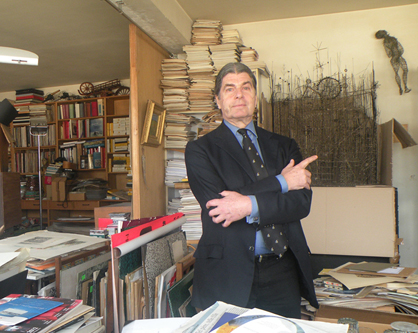ARMLEDER / CARZOU – RICHARD
T: 33 (0)1 43 25 27 22
Galerie Richard in Paris presents John M Armleder – Jean Carzou, a duo exhibition, from October 18 through December 20, 2014.
This exhibition is the second part of the exhibition at Galerie Richard in New York.
The young Karnik Zouloumian, born in 1907 in Allepo, Syria, settled with his Armenian family in Egypt and was a brilliant student in Cairo. At age 17, he went to Paris to study architecture at the “Ecole Spéciale d’ Architecture”. After his graduation in 1930, he made paintings with “Squares and Circles” and changed his name to Jean Carzou out of a desire to better integrate himself into French society. He became known relatively quickly thanks to his stage designs for the Opéra de Paris, becoming a household name in the 50’s with his sets for the Comédie Française. In 1955 the art magazine “Connaissance des Arts” rated him as one of the ten most important painters of his generation. His sharp graphic style became extremely popular in the 60’s and 70’s with no other French artist achieving the same level of popularity since. Jean Carzou at the time was on the cutting edge of figurative painting the way George Mathieu and Victor Vasarely were to abstract painting. The RTL radio station invited these three leading artists to conceive of a new design for the façade of its Parisian building. In 1972 the radio station selected Vasarely’s proposal, an Op art motif and clear technophile symbol of the 70’s.
In 1969 John M Armleder (born in 1948 in Geneva) created with other artists close to the Fluxus group, the group “Ecart”, and they conceived a gallery of the same name. John M Armleder has developed a body of work that is incredibly subtle and complex. His approach is based on the idea that his work evolves in relationship with things that already exist. He operates without irony through the scrambling and dismantling of art hierarchies. In this show he takes the risk to reevaluate the work of Jean Carzou, star of the 60’s and 70’s, relegated to the rank of minor artist.
It is difficult to imagine that Jean Carzou and John Armleder could be contemporaries. Carzou at the height of his fame, member of the “Beaux Arts Academy”, had made a few blunders condemning without reserve Picasso and Cézanne, who in his view were symbols of the “decadence in painting”. He garnered a great deal of hostility from the art world with such radical statements. All this shows the irony-free audacity of John Armleder who gambles big to celebrate a loser. The philosopher Jean Toussaint Desanti explains in his autobiography that the philosopher is the one who must gamble with the totality of his knowledge and ideas. It would take new genealogies to handle the dual presence of Jean Carzou and John Armleder. Only the disconcerting and astute intelligence of John Armleder is modestly present here.
The “Pour and Puddle” paintings are stretched canvasses laid on the floor onto which the artist pours paint, lacquer and varnish. Their execution is a matter of quick decision – the careful manipulation of different chemical substances as they interact together on the canvas. The paintings clearly reveal their production process: a handling of paint through which failure, success and abandonment are equalized. John Armleder’s work defies the hierarchy of programmatic intention, while challenging and questioning its own authority.
These works also bring to mind the “Dendrites” of George Sand (1804-1870), a writer that Carzou could also have illustrated. These watercolor paintings belong to the history of natural and accidental images used or produced by artists to stimulate their imagination. She used randomness to create landscapes, “to make nature real”. Modest and cunning craftsmanship puts to an end the vanities of subjectivity. One could trace a subversive history of these unassuming craftsmen whose work has a time-delayed capacity to take effect and make their impact felt.
Cécile Calé, Curator and Art advisor, Paris May 2014.
